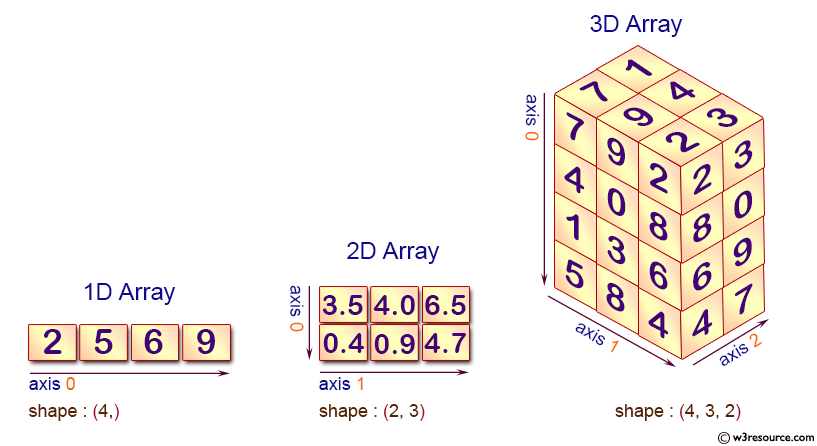NumPy: Array creation routines
Array creation routines

| Ones and zeros | ||
| Name | Description | Syntax |
|---|---|---|
| empty() | Return a new array of given shape and type, without initializing entries. | numpy.empty(shape[, dtype, order]) |
| empty_like | Return a new array with the same shape and type as a given array. | numpy.empty_like(a[, dtype, order, subok]) |
| eye() | Return a 2-D array with ones on the diagonal and zeros elsewhere. | numpy.eye(N[, M, k, dtype]) |
| identity() | Return the identity array. | numpy.identity(n[, dtype]) |
| ones() | Return a new array of given shape and type, filled with ones. | numpy.ones(shape[, dtype, order]) |
| ones_like | Return an array of ones with the same shape and type as a given array. | numpy.ones_like(a[, dtype, order, subok]) |
| zeros | Return a new array of given shape and type, filled with zeros. | numpy.zeros(shape[, dtype, order]) |
| zeros_like | Return an array of zeros with the same shape and type as a given array. | numpy.zeros_like(a[, dtype, order, subok]) |
| full() | Return a new array of given shape and type, filled with fill_value. | numpy.full(shape, fill_value[, dtype, order]) |
| full_like() | Return a full array with the same shape and type as a given array. | numpy.full_like(a, fill_value[, dtype, order, subok]) |
Pictorial Presentation: NumPy Array creation
| From existing data | ||
| Name | Description | Syntax |
|---|---|---|
| array() | Create an array. | numpy.array(object[, dtype, copy, order, subok, ndmin]) |
| asarray() | Convert the input to an array. | numpy.asarray(a[, dtype, order]) |
| asanyarray() | Convert the input to an ndarray, but pass ndarray subclasses through. | numpy.asanyarray(a[, dtype, order]) |
| ascontiguousarray() | Return a contiguous array in memory (C order). | numpy.ascontiguousarray(a[, dtype]) |
| asmatrix() | Interpret the input as a matrix. | numpy.asmatrix(data[, dtype]) |
| copy() | Return an array copy of the given object. | numpy.copy(a[, order] |
| frombuffer() | Interpret a buffer as a 1-dimensional array. | numpy.frombuffer(buffer[, dtype, count, offset]) |
| fromfile() | Construct an array from data in a text or binary file. | numpy.fromfile(file[, dtype, count, sep]) |
| fromfunction() | Construct an array by executing a function over each coordinate. | numpy.fromfunction(function, shape, **kwargs) |
| fromiter() | Create a new 1-dimensional array from an iterable object. | numpy.fromiter(iterable, dtype[, count]) |
| fromstring() | A new 1-D array initialized from raw binary or text data in a string. | numpy.fromstring(string[, dtype, count, sep]) |
| loadtxt() | Load data from a text file. | numpy.loadtxt(fname[, dtype, comments, delimiter, ...]) |
Creating record arrays (numpy.rec) |
||
| Name | Description | Syntax |
|---|---|---|
| core.records.array() | Construct a record array from a wide-variety of objects. | core.defchararray.array(obj[, itemsize, ...]) |
| core.records.fromarrays() | create a record array from a (flat) list of arrays | core.records.fromarrays(arrayList[, dtype, ...]) |
| core.records.fromrecords() | create a recarray from a list of records in text form. | core.records.fromrecords(recList[, dtype, ...]) |
| core.records.fromstring() | create a (read-only) record array from binary data contained in a string. | core.records.fromstring(datastring[, dtype, ...]) |
| core.records.fromfile() | Create an array from binary file data. | core.records.fromfile(fd[, dtype, shape, ...]) |
Creating character arrays (numpy.char) |
||
| Name | Description | Syntax |
|---|---|---|
| core.defchararray.array() | Create a chararray. | core.defchararray.array(obj[, itemsize, ...]) |
| core.defchararray.array() | Convert the input to a chararray, copying the data only if necessary. | core.defchararray.asarray(obj[, itemsize, ...]) |
| Numerical ranges | ||
| Name | Description | Syntax |
|---|---|---|
| arange() | Return evenly spaced values within a given interval. | numpy.arange([start,] stop[, step,][, dtype]) |
| linspace() | Return evenly spaced numbers over a specified interval. | numpy.linspace(start, stop[, num, endpoint, ...]) |
| logspace() | Return numbers spaced evenly on a log scale. | numpy.logspace(start, stop[, num, endpoint, base, ...]) |
| geomspace() | Return numbers spaced evenly on a log scale (a geometric progression). | numpy.geomspace(start, stop[, num, endpoint, dtype]) |
| meshgrid() | Return coordinate matrices from coordinate vectors. | numpy.meshgrid(*xi, **kwargs) |
| mgrid() | nd_grid instance which returns a dense multi-dimensional "meshgrid". | numpy.mgrid |
| ogrid() | nd_grid instance which returns an open multi-dimensional "meshgrid". | numpy.ogrid |
| Building matrices | ||
| Name | Description | Syntax |
|---|---|---|
| diag() | Extract a diagonal or construct a diagonal array. | numpy.diag(v[, k]) |
| diagflat() | Create a two-dimensional array with the flattened input as a diagonal. | numpy.diagflat(v[, k]) |
| tri() | An array with ones at and below the given diagonal and zeros elsewhere. | numpy.tri(N[, M, k, dtype]) |
| tril() | Lower triangle of an array. | numpy.tril(m[, k]) |
| triu() | Upper triangle of an array. | numpy.triu(m[, k]) |
| vander() | Generate a Vandermonde matrix. | numpy.vander(x[, N, increasing]) |
| The Matrix class | ||
| Name | Description | Syntax |
|---|---|---|
| mat() | Interpret the input as a matrix. | numpy.mat(data[, dtype]) |
| bmat() | Build a matrix object from a string, nested sequence, or array. | numpy.bmat(obj[, ldict, gdict]) |
Previous: NumPy ndarray
Next: Ones and Zeros
empty()
